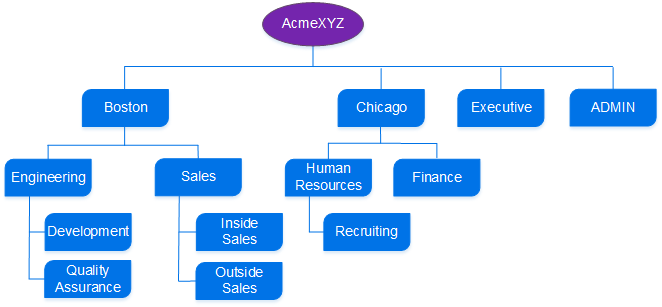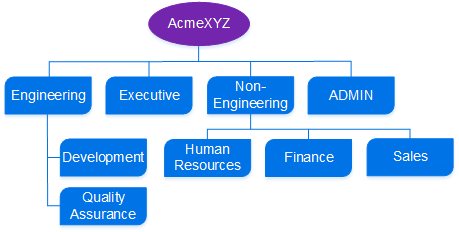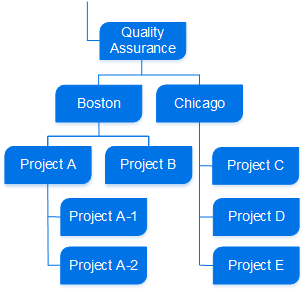Group hierarchy examples
Connected groups enable you to replicate your corporate organizational structure so that you can manage and monitor your user base at any level of granularity. This topic provides several examples of how Jane, a Data Admin in the ADMIN group at the fictitious company AcmeXYZ, organizes her company's Connected group hierarchy based on the corporate objectives that she wants to meet.
Scenario 1
Jane wants an organizational structure that lets her meet two main objectives:
- Tightly control Connected functions based on departmental requirements
- Monitor user and device data by geographical location
To meet these goals, Jane creates the following hierarchy.

This structure organizes all non-executive users by geographical location so that Jane can easily generate reports based on those locations. Also, the use of departmental subgroups enables her to control Connected functions at a granular level through group-specific policies.
Scenario 2
Now, suppose that Jane wants to set up her organizational structure based on these objectives:
- Most departments require the same Connected functions
- Monitor user and device data based on broad corporate role rather than geographic location
To do so, Jane creates the following hierarchy.

The top level of this structure places emphasis on the corporate role of users rather than their geographical location. In addition, it does not have many subgroups because Jane's objectives do not require her control at the same level of granularity as in the previous scenario. For example, the policy that you apply to the Human Resources (HR) group will apply to all users in that group, regardless of whether users belong to different corporate departments within HR, such as Benefits, Recruiting, and so on.
Scenario 3
In this last scenario, Jane delegates administration of the Quality Assurance (QA) group to Bill, who is a Group Admin in that group. Unlike Jane, who can create and administer groups anywhere in the corporate hierarchy in her role as a Data Admin, Bill can administer and create groups only in his own group and below. The hierarchy that he creates, however, can be as complex as required to meet his needs. For example, he has the following objectives:
- Tightly control Connected functions based on QA projects
- Monitor user and device data based on geographical location
So, he creates the this group hierarchy:

The subgroup structure that Bill creates organizes QA projects by geographical location. The use of project-specific subgroups enables him to control Connected functions at a granular level through group-specific policies. Although Bill created this group hierarchy, both he and Jane (a Data Admin) have full administrative control over it.
For a detailed example of groups and users that illustrates different spans of administrative control, see User and group hierarchy example.